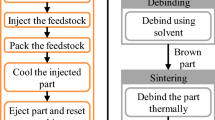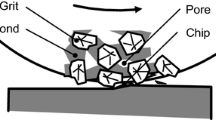Abstract
The paper develops a unit process life cycle inventory (UPLCI) for gas metal arc welding (GMAW) process. UPLCI is a modeling approach that allows users to estimate the energy and materials flow of a unit process. A UPLCI model can be reused in different manufacturing settings where a wide range of machines and materials are used. GMAW is in the joining category of the taxonomy of manufacturing processes, and this work is part of the effort to build UPLCI models for all common manufacturing processes. Following UPLCI approach, the energy consumption is not limited to the energy needed to initiate and maintain the arc (i.e. active energy). Energy spent during idle and standby are also accounted. An example calculation is provided to demonstrate how the GMAW model can be used. It should be noted that the GMAW model can be linked to UPLCI models of other unit processes. This makes it possible to estimate the materials loss and energy use (thus environmental impacts) of a product made by a sequence of manufacturing processes.



Similar content being viewed by others
Abbreviations
- LCI:
-
Life cycle inventory
- UPLCI:
-
Unit process life cycle inventory
- GMAW:
-
Gas metal arc welding
- CO2 :
-
Carbon dioxide
- Ar:
-
Argon
- A:
-
Weld cross sectional area
- a:
-
Leg length of weld cross section
- cp,electrode :
-
Specific heat of electrode
- cp,sub :
-
Specific heat of melted substrate
- d:
-
Gap width of square-groove butt weld
- delectrode :
-
Diameter of electrode
- E:
-
Electricity consumption by arc
- Ea :
-
Actual electricity consumption
- Ebasic :
-
Basic energy
- Eidle :
-
Idle energy
- Etip :
-
Tip energy
- Etotal :
-
Total energy
- F:
-
Wire feed speed
- f1 :
-
Arc efficiency
- f2 :
-
Melting efficiency
- f3 :
-
Fraction of total heat in the super-heated molten drop of electrode material out of total energy supplied to the welding pool
- ∆Hf,electrode :
-
Latent heat of fusion for electrode
- ∆Hf,sub :
-
Latent heat of fusion for melted substrate
- I:
-
Arc current
- L:
-
Length of weld
- melectrode :
-
Mass of electrode consumption
- melectrode loss :
-
Mass of electrode loss
- mfume :
-
Mass of fume
- mgas,i :
-
Mass of shield gas i
- msub :
-
Melted substrate
- mweld :
-
Mass of weld
- Pidle :
-
Idle power
- Pbasic :
-
Basic power
- Ptip :
-
Tip power
- Qbm :
-
Heat generated is lost to the surrounding base metal due to conduction
- Qenv :
-
Heat generated is lost to the environment due to convection and radiation
- Qg :
-
Flow rate
- Qheat loss :
-
Heat loss
- Qpool :
-
Heat needed to create the welding pool
- T:
-
Thickness of the metal
- tidle :
-
Idle time
- tbasic :
-
Basic time
- ttip :
-
Tip time
- U:
-
Arc voltage
- Vtravel :
-
Travel speed
- Vi :
-
Volume of shield gas i
- V:
-
Total volume of shield gas
- ρ electrode :
-
Electrode density
- ρ Ar :
-
Argon density
- \({\rho _{{\text{C}}{{\text{O}}_2}}}\) :
-
CO2 density
- ρ i :
-
Density of shield gas i
- \({{{\eta}} _{{\text{electrode}}}}\) :
-
Electrode efficiency
- \({\eta _{{\text{inverter}}}}\) :
-
Convert electricity consumed by arc to actual energy from power grid
- θ i :
-
Composition of shield gas
References
Luttikhuis EO, Toxopeus ME, Overcash M (2013) Applying unit process life cycle inventory (UPLCI) methodology in product/packaging combinations. In: Re-engineering manufacturing for sustainability, Springer, pp 15–20
Kellens K, Dewulf W, Overcash M, Hauschild MZ, Duflou JR (2012) Methodology for systematic analysis and improvement of manufacturing unit process life-cycle inventory (UPLCI)—CO2 PE! initiative (cooperative effort on process emissions in manufacturing). Part 1: methodology description. Int J Life Cycle Assess 17(1):69–78
Overcash M, Twomey J, Isaacs J (2009) Manufacturing unit process life cycle inventories (Uplci). In: Proceedings of the 9th workshop on performance metrics for intelligent systems, pp 30–31
Overcash M, Twomey J (2012) Unit process life cycle inventory (UPLCI)—a structured framework to complete product life cycle studies. In: Leveraging technology for a sustainable world, Springer, pp 1–4
Nadzam J, Armao F, Byall L, Kotecki D, Miller D (2006) GMAW welding guide. Linc. Electr. Co. Clevel, Ohio
Linke B, Overcash M (2017) Reusable unit process life cycle inventory for manufacturing: grinding. Prod Eng 11(6):643–653
Cary HB (1995) Arc welding automation. CRC Press, Boca Raton
Kearns LP (ed) (1978) Welding Handbook, vol 2. American Welding Society, Miami, FL
Watkins AD, Smartt H, Einerson CJ (1990) Heat transfer in gas metal arc welding. In: Proceedings of recent trends in welding science and technology, pp 19–23
Lancaster JF (1984) The physics of welding. Phys Technol 15(2):73
DuPont JN, Marder AR (1995) Thermal efficiency of arc welding processes. Weld J-Includ Weld Res Suppl 74(12):406s
Wells AA (1952) Heat flow in welding. Weld J 31:263s–267s
Okada A (1977) Application of melting efficiency and its problems. J Jpn Weld Soc 46(2):53–61
Fuerschbach PW, Knorovsky G (1991) A study of melting efficiency in plasma arc and gas tungsten arc welding. Weld J USA 70(11):287
O’Brien RL (1991) American welding ociety eighth edition. Weld Handb 2:86
Sproesser G, Pittner A, Rethmeier M (2016) Increasing performance and energy efficiency of gas metal arc welding by a high power tandem process. Procedia CIRP 40:643–648
Sproesser G, Chang Y-J, Pittner A, Finkbeiner M, Rethmeier M (2017) Energy efficiency and environmental impacts of high power gas metal arc welding. Int J Adv Manuf Technol 91(9–12):3503–3513
Pires I, Quintino L, Amaral V, Rosado T (2010) Reduction of fume and gas emissions using innovative gas metal arc welding variants. Int J Adv Manuf Technol 50(5–8):557–567
Dennis JH, Hewitt PJ, Redding CA, Workman AD (2001) A model for prediction of fume formation rate in gas metal arc welding (GMAW), globular and spray modes, DC electrode positive. Ann Occup Hyg 45(2):105–113
Soderstrom EJ, Scott KM, Mendez PF (2011) Calorimetric measurement of droplet temperature in GMAW. Weld J 90(4):77–84
Acknowledgements
The authors would like to acknowledge Michael Overcash, Janet Twomey, and Jackie Isaacs for their work on developing the unit process life cycle inventory methodology. We also acknowledge Vance Murray for his contribution to data collection. Thanks also go to John W. Sutherland and Michael Overcash for their feedbacks.
Author information
Authors and Affiliations
Corresponding author
Rights and permissions
About this article
Cite this article
Zhang, H., Zhao, F. Reusable unit process life cycle inventory for manufacturing: gas metal arc welding. Prod. Eng. Res. Devel. 13, 89–97 (2019). https://doi.org/10.1007/s11740-018-0869-1
Received:
Accepted:
Published:
Issue Date:
DOI: https://doi.org/10.1007/s11740-018-0869-1




